Who Was The First Computer Inventor: Key Facts, Dates And Stories
One creation in the fabric of human creativity, a marvel that redefined possibility itself, sits as the sentinel of modernity: the computer. It gives data life, unlocks spheres of knowledge, and connects us across enormous digital landscapes. It is a symphony of circuits and algorithms.
The computer has woven itself into every aspect of our existence, evolving from room-filling devices to sleek companions that fit in our palms. This transformation began with the visionary aspirations of Charles Babbage and continues today in Silicon Valley. The computer restarts to be our dependable navigator as we navigate the information seas of the digital era. It does it with unwavering grace.
Inventor of the Computer

Charles Babbage – 1860.jpg See page for author, Public domain, via Wikimedia Commons
The development of the computer was a long process that took place over several centuries and involved contributions from numerous scientists, engineers, and mathematicians, thus it cannot be credited to a single person.
However, Charles Babbage, with his designs for the Analytical Engine in the 19th century, is frequently acknowledged as a crucial influence in the development of early computer concepts.
Some people refer to Babbage as the “father of the computer”. Babbage is credited with creating the first mechanical computer, the Difference Engine, which eventually inspired more intricate electronic designs. However, Babbage’s Analytical Engine, which was programmed using a concept openly adapted from the Jacquard loom, contains all the fundamental concepts of modern computers.
In addition to his work on computers, which was documented in his 1832 book Economy of Manufactures and Machinery, Babbage had a wide range of interests. Among the many polymaths of his century, he has been referred to as “pre-eminent” due to his diverse work in various subjects.
Read On 10 Facts About Charles Babbage
Key Facts about the invention of the computer
Here are some of the key facts about the inventor and the invention of the computer.
1. Charles Babbage conceptualized and invented the first mechanical computer in the early 19th century

IBM Personal Computer (1981).jpgFederigo Federighi, CC BY-SA 4.0, via Wikimedia Commons
After developing his difference engine, he published a paper to the Royal Astronomical Society titled “Note on the application of machinery to the computation of astronomical and mathematical tables” in 1822. He also designed his difference engine to assist in navigational calculations, but in 1833 he realized that a much more general design, an analytical engine, was feasible.
Punched cards, which were then used to control mechanical looms like the Jacquard loom, were to be used to enter programming and data into the machine.
The device would feature a printer, a curve plotter, and a bell for output. Additionally, the device could punch numbers into cards to be read in at a later time. The Engine was the first general-purpose computer architecture that might be referred to as Turing-complete in current parlance because it included an arithmetic logic unit, conditional branching and loops, and integrated memory.
2. Analogue computers were invented in the early 19th century
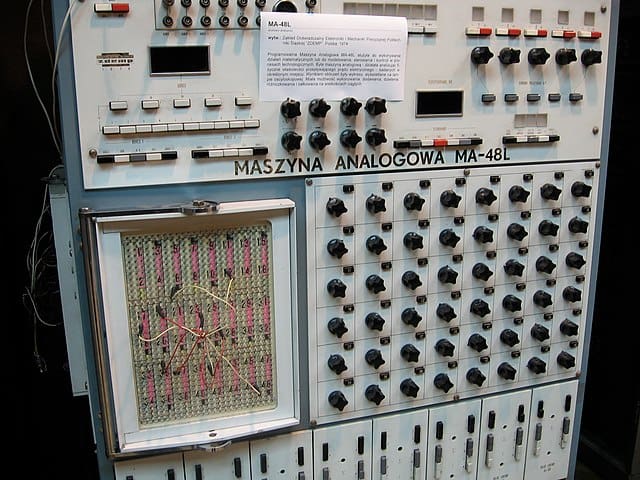
MA-48L analogue computer, pt. 2 (2232405554) (2).jpg Marcin Wichary from San Francisco, U.S.A., CC BY 2.0, via Wikimedia Commons
Many scientific computing requirements were met in the early part of the 20th century by progressively advanced analogue computers, which computed directly from a mechanical or electrical model of the problem. These, however, lacked the adaptability and precision of contemporary digital computers and were not programmable.
The earliest analogue computer was a tide-predicting device created in 1872 by Sir William Thomson, who would eventually become Lord Kelvin. The differential analyser was invented in 1876 by James Thomson, the older brother of the more well-known Sir William Thomson. It is a mechanical analogue computer that uses wheel-and-disc mechanisms to solve differential equations through integration.
The differential analyzer, developed at MIT beginning in 1927 by H. L. Hazen and Vannevar Bush, is the pinnacle of mechanical analogue computing. This expanded on H. W. Nieman’s torque amplifiers and James Thomson’s mechanical integrators. Before it became clear that these gadgets were obsolete, a dozen of them were constructed.
3. Early digital computers were electromechanical

A Woman using an early digital computer. jpg University of Texas at Arlington Photograph Collection, CC BY 4.0, via Wikimedia Commons
Early digital computers were electromechanical; to do the calculation, electric switches drove mechanical relays. These machines operated at a slow speed and were subsequently replaced by all-electric computers that operate significantly quicker and were built initially with vacuum tubes. One of the earliest examples of an electromechanical relay computer was the Z2, developed by German engineer Konrad Zuse in Berlin in 1939.
In 1941, Zuse developed the Z3, which was the first operational electromechanically programmed, completely autonomous digital computer ever made. The Z3 was constructed using 2000 relays, and it implemented a word length of 22 bits that ran at a clock frequency of roughly 5–10 Hz. Data could be entered from the keyboard or saved in 64 words of memory, while program code was provided on punched film.
4. Vacuum tubes and digital electronic circuits replaced the electromechanical computers
Purely electronic circuit components quickly replaced their mechanical and electromechanical counterparts, while analogue calculation was replaced by digital.
In the 1930s, Tommy Flowers, an engineer, investigated the potential use of electronics for the telephone exchange when he was employed at the Post Office Research Station in London.
He constructed a piece of machinery in 1934, and it was put into use five years later. Thousands of vacuum tubes are used to create an electronic data processing system out of a section of the telephone exchange network.
The first “automatic electronic digital computer” was created and tested in the US in 1942 by John Vincent Atanasoff and Clifford E. Berry of Iowa State University. With around 300 vacuum tubes and capacitors set in a mechanically revolving drum for memory, this design was also entirely electrical.
5. The principle of the modern computer was proposed by Alan Turing
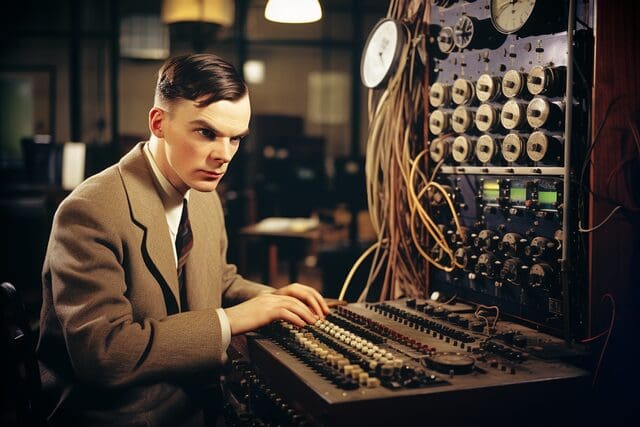
Alan Turing working in the Laboratory (artistic depiction by Thomas Nordwest).png Thomas Nordwest, CC BY-SA 4.0, via Wikimedia Commons
Alan Turing’s groundbreaking 1936 paper, On Computable Numbers, outlined the basic idea behind the modern computer. The “universal computing machine” that Turing proposed is today referred to as a universal Turing machine. By running programs recorded on tape, which made the machine programmable, he demonstrated that such a machine is capable of computing anything that is capable of being computed.
The stored program, in which all of the computing instructions are saved in memory, is the central idea of Turing’s system. The fundamental idea behind the modern computer was credited to this work, according to Von Neumann.
Even today, a key topic of study in the theory of computation is Turing machines. Modern computers are claimed to be Turing-complete, which means they have algorithm execution capacity similar to a universal Turing machine, with the exception of the restrictions imposed by their limited memory storage.
6. Early computing machines had fixed programs
Rewiring and reorganizing the machine was necessary in order to change its function. This changed with the invention of the stored-program computer. An instruction set is built into a stored-program computer by design, and it has the ability to store a set of instructions (a program) in memory.
The first computer with stored programs was called the Manchester Baby. It was created by Frederic C. Williams, Tom Kilburn, and Geoff Tootill at the University of Manchester in England, and it ran its first program on June 21, 1948. The Williams tube, the first random-access digital storage device, was intended to be tested on it.
The Ferranti Mark 1, the first general-purpose computer to be sold commercially, was shortly based on the Mark 1.
Key Dates on the Invention of the Computer
The invention and development of the computer span many years and involve numerous significant events. Here are some key dates in the history of computer invention:
1. 1642 – The Invention of the PASCALINE

Pascaline calculator.jpgBlaise Pascal, Public domain, via Wikimedia Commons
In 1642, Blaise Pascal created the mechanical calculator known as Pascal’s calculator, sometimes referred to as the arithmetic machine or Pascaline. The time-consuming mathematical calculations Pascal’s father had to perform in his role as Rouen’s tax supervisor inspired him to create a calculator.
He created the device to conduct multiplication and division by repeatedly adding or subtracting two integers as well as straight addition and subtraction of the two numbers. The Pascaline is an important link to the creation of the computer.
2. 1822 – The Difference Engine

Babbage Difference Engine (Being utilised).jpg Jitze Couperus from Los Altos Hills, California, USA, CC BY 2.0, via Wikimedia Commons
An automatic mechanical calculator called a difference engine is used to tabulate polynomial functions. It was initially developed by Charles Babbage in the 1820s. The term “difference engine” comes from the process of split differences, which makes use of a limited number of polynomial coefficients to interpolate or tabulate functions.
A difference engine may generate a lot of useful tables because many of the mathematical functions that are used often in engineering, science, and navigation are built from trigonometric and logarithmic functions, which can be approximated by polynomials.
3. 1833 – The Analytical Engine

Babbages Analytical Engine, 1834-1871. (9660574685).jpg Charles Babbage, CC BY-SA 2.0, via Wikimedia Commons
The analytical engine was the first general-purpose computer architecture that, in today’s terms, could be characterized as Turing-complete since it included an arithmetic logic unit, control flow in the form of conditional branching and loops, and integrated memory.
In other words, the analytical engine’s structure was very similar to the one that dominated computer design throughout the electronic era. One of Charles Babbage’s greatest successes is the analytical engine.
4. Late 1800s – Herman Hollerith develops the punched card system for tabulating and processing data
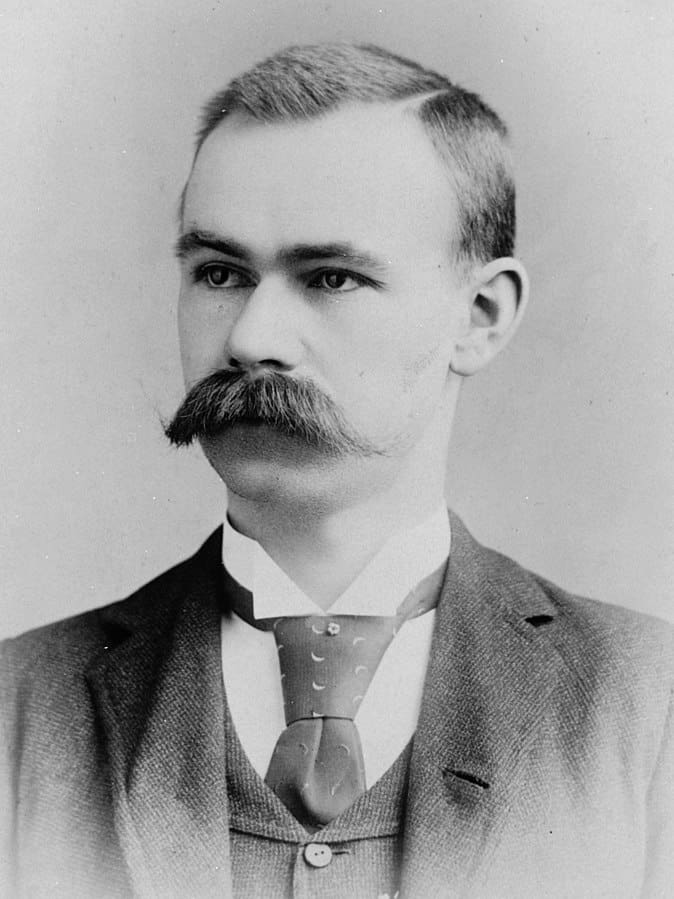
Hollerith.jpg Charles Milton Bell, Public domain, via Wikimedia Commons
He also created the first keypunch and automatic card feeder. The 1890 Tabulator was built from the ground up to work with 1890 Census cards. His 1906 Type I Tabulator had a control panel that made rewiring for various purposes easier.
The detachable control panel from the 1920s enabled prewiring and almost immediate job switching. These innovations laid the groundwork for the data processing business, and Hollerith’s punched cards—later used for computer input and output—were in use for over a century.
5. 1936 – the invention of The Turing Machine
Alan Turing created the Turing machine in 1936; he referred to it as a “a-machine” (automatic machine). The canonical Turing machine uses sequential memory to store data, and it is an idealized representation of a central processing unit (CPU) that manages all data manipulation performed by a computer. Typically, the system may read from and write to an infinitely long tape to represent the sequential memory.
6. 1941-1945 – Konrad Zuse developed the Z3

Z3 Deutsches Museum.JPGVenusianer, CC BY-SA 3.0, via Wikimedia Commons
Konrad Zuse created the Z3, a German electromechanical computer, in 1938. It was finished in 1941. It was the first operational, fully automatic, programmable digital computer ever.
With 2,600 relays and a 22-bit word length that ran at a clock frequency of roughly 5–10 Hz, the Z3 was constructed. The punched film was used to store the program code. Initial values were manually entered.
Read On The History of Email: Who Invented It and How Did It Evolve?
7. 1945 – the first general-purpose electronic digital computer, is completed by J. Presper Eckert and John Mauchly
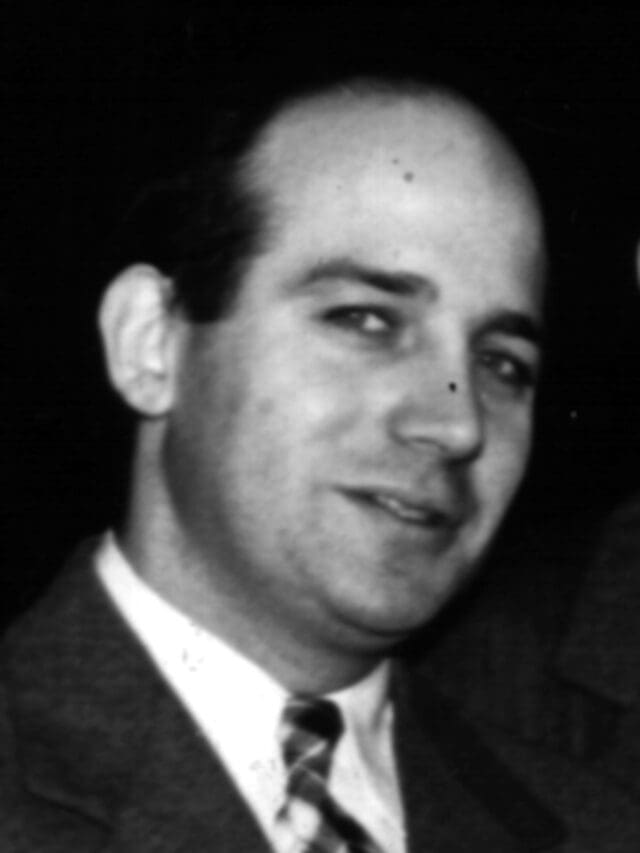
ARL ENIAC 05 (cropped) – John Presper Eckert.png U.S. Army Photo, Public domain, via Wikimedia Commons
The first programmable, electronic, general-purpose digital computer, called ENIAC (Electronic Numerical Integrator and Computer), was created in 1945. These features might be found in combinations on other computers, but the ENIAC had them all in one device. It could solve “a large class of numerical problems” through reprogramming and was Turing-complete.
ENIAC’s first program was a study of the viability of the thermonuclear bomb, even though it was built and largely used to generate artillery firing tables for the United States Army’s Ballistic Research Laboratory (which eventually became a part of the Army Research Laboratory).
8. 1951 – the first commercially produced computer, is delivered to the United States Census Bureau
On March 31, 1951, the United States Census Bureau accepted the first Univac, and on June 14 of that same year, it was dedicated. CBS used the fifth machine, which was created for the U.S. Atomic Energy Commission, to forecast the outcome of the 1952 presidential election. It notably projected an Eisenhower victory with a sample of just 5.5% of the electorate.
9. 1969 – The first successful message is sent over the ARPANET
The Advanced Research Projects Agency Network (ARPANET) was one of the earliest computer networks to implement the TCP/IP protocol suite as well as the first wide-area packet-switched network with distributed control. Both of these innovations evolved into the Internet’s underlying technology. The Advanced Research Projects Agency (ARPA) of the US Department of Defense created the ARPANET.
In 1969, the first computers were interconnected, and in 1970, the Network Control Protocol was put into use. In 1971, the network was deemed operational. Email, file transmission, and remote login were made possible by further software development. In 1975, the Defense Communications Agency assumed operational responsibility for the rapidly expanding network.
Stories about the invention of the computer
Here are some stories about the invention of the computer;
1. Babbage and the Analytical Engine’s Vision
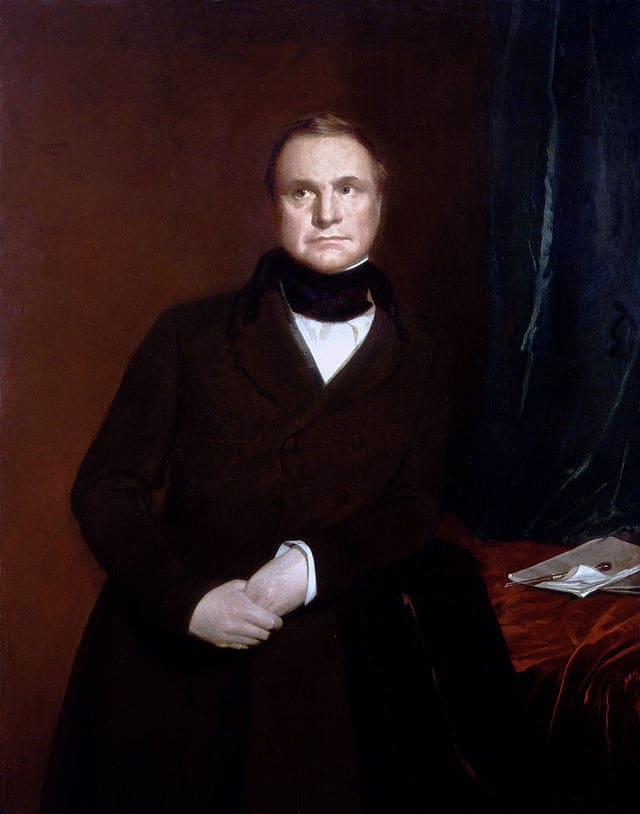
Charles Babbage by Samuel Laurence.jpg Samuel Laurence, Public domain, via Wikimedia Commons
The Analytical Engine was conceptualized in a groundbreaking way by Charles Babbage. He developed a mechanical apparatus that could compute and carry out commands in the 1830s that was quite similar to a modern computer.
The machine had programming tools like punch cards and a memory unit. Babbage’s partner Ada Lovelace published voluminous notes on the Engine, foreseeing uses for it beyond the computation of numbers, including the production of music and art.
2. Ada Lovelace’s First Computer Program

Ada lovelace.png Alfred Edward Chalon, Public domain, via Wikimedia Commons
In 1843, Ada Lovelace created a series of notes outlining a method for the Analytical Engine to generate Bernoulli numbers as a result of her collaboration with Charles Babbage. She became the first person to create a program for a machine that didn’t even exist yet thanks to her notes that provided a thorough explanation of the procedure. The idea of computer programming was founded by Lovelace’s contributions.
3. Alan Turing’s Code-Breaking Machines
Alan Turing was instrumental in creating machines that could decrypt German signals that were encrypted during World War II. His creation, the Bombe, made a crucial contribution to the Allied victory by aiding in the cracking of the German Enigma code. Turing’s contributions revealed the usefulness of computing technology and the capability of machines to perform intricate computations.
Read On Top 15 Facts about Alan Turing
4. The Birth of Silicon Valley
In a garage in Palo Alto, California, William Hewlett and David Packard founded Hewlett-Packard (HP) in 1939. This is frequently regarded as one of the key occasions that helped shape Silicon Valley into a centre for technical innovation. Later, the garage startup culture would come to be associated with the entrepreneurial and innovative attitude that still fuels the tech sector.
5. The Home Computer Revolution
Personal computers were created in the middle of the 1970s as a result of the introduction of microprocessors. When they jointly launched Apple Computers in 1976, Steve Jobs and Steve Wozniak introduced the Apple I, a pre-assembled circuit board.
This signaled the start of the personal computer revolution, which made computing technology available to those outside of the scholarly and professional worlds.
The computer is a masterpiece created from imaginative and inventive threads in the vast tapestry of human creation. It has changed the world, from Babbage’s visions to Lovelace’s algorithms, from Turing’s cryptography to the personal computing revolutions. The computer’s narrative goes on, evolving in a never-ending symphony of development and opportunity.
Read On 45 Greatest Engineers of All Time
Planning a trip to Paris ? Get ready !
These are Amazon’s best-selling travel products that you may need for coming to Paris.
Bookstore
- The best travel book : Rick Steves – Paris 2023 – Learn more here
- Fodor’s Paris 2024 – Learn more here
Travel Gear
- Venture Pal Lightweight Backpack – Learn more here
- Samsonite Winfield 2 28″ Luggage – Learn more here
- Swig Savvy’s Stainless Steel Insulated Water Bottle – Learn more here
Check Amazon’s best-seller list for the most popular travel accessories. We sometimes read this list just to find out what new travel products people are buying.







